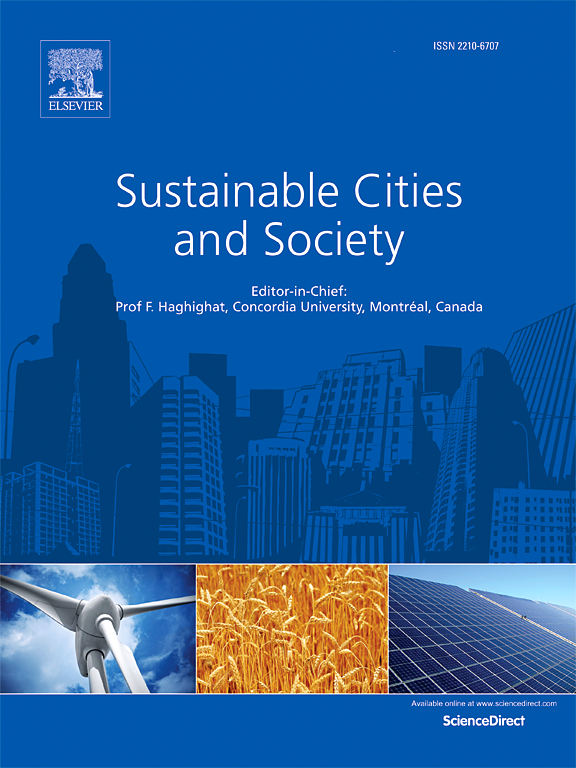Relationship Between Urban Tree Diversity and Human Well-being: Implications for Urban Planning
IF 10.5
1区 工程技术
Q1 CONSTRUCTION & BUILDING TECHNOLOGY
引用次数: 0
Abstract
Green spaces and trees are key elements for enhancing human well-being in cities. Despite recognizing the significance of urban greenery for human health, the role of urban biodiversity in shaping well-being remains poorly understood. This study focused on the interplay between tree genera diversity, perceived urban biodiversity, and the subjective well-being of urban residents in Karlsruhe, Germany. A map-based online questionnaire involving 302 participants investigated well-being locations and perceptions of biodiversity. Tree genera diversity was assessed for nine genera using remote-sensing and ground data. A novel approach of spatially correlating societal mapping results and tree genera cover maps revealed a clear preference for green spaces in the built-up urban environment. The relations between computed tree genera diversity and subjective well-being were unclear. However, there was a significant relationship between the perceived biodiversity of urban green spaces and subjective well-being. The amount of tree cover, the abundance of large trees, as well as the perceived species diversity beyond tree genera, lead to increased well-being of the urban population. At the same time, a perceived unkemptness of urban areas had a negative effect on the residents’ well-being. This should be considered in future research and the design of urban green spaces.
城市树木多样性与人类福祉的关系:对城市规划的启示
绿色空间和树木是提高城市人类福祉的关键要素。尽管认识到城市绿化对人类健康的重要性,但人们对城市生物多样性在塑造福祉方面的作用仍然知之甚少。本研究聚焦于德国卡尔斯鲁厄市树种多样性、感知城市生物多样性和城市居民主观幸福感之间的相互作用。一份基于地图的在线问卷调查了302名参与者对幸福地点和生物多样性的看法。利用遥感和地面资料对9个属的树种多样性进行了评价。一种将社会制图结果与树木属覆盖图进行空间关联的新方法揭示了在已建成的城市环境中对绿色空间的明显偏好。计算树属多样性与主观幸福感之间的关系尚不清楚。然而,城市绿地的感知生物多样性与主观幸福感之间存在显著的关系。树木覆盖的数量、大树的丰度以及树种以外的物种多样性增加了城市人口的幸福感。与此同时,城市地区的不整洁对居民的幸福感有负面影响。在未来的研究和城市绿地的设计中应该考虑到这一点。
本文章由计算机程序翻译,如有差异,请以英文原文为准。
求助全文
约1分钟内获得全文
求助全文
来源期刊

Sustainable Cities and Society
Social Sciences-Geography, Planning and Development
CiteScore
22.00
自引率
13.70%
发文量
810
审稿时长
27 days
期刊介绍:
Sustainable Cities and Society (SCS) is an international journal that focuses on fundamental and applied research to promote environmentally sustainable and socially resilient cities. The journal welcomes cross-cutting, multi-disciplinary research in various areas, including:
1. Smart cities and resilient environments;
2. Alternative/clean energy sources, energy distribution, distributed energy generation, and energy demand reduction/management;
3. Monitoring and improving air quality in built environment and cities (e.g., healthy built environment and air quality management);
4. Energy efficient, low/zero carbon, and green buildings/communities;
5. Climate change mitigation and adaptation in urban environments;
6. Green infrastructure and BMPs;
7. Environmental Footprint accounting and management;
8. Urban agriculture and forestry;
9. ICT, smart grid and intelligent infrastructure;
10. Urban design/planning, regulations, legislation, certification, economics, and policy;
11. Social aspects, impacts and resiliency of cities;
12. Behavior monitoring, analysis and change within urban communities;
13. Health monitoring and improvement;
14. Nexus issues related to sustainable cities and societies;
15. Smart city governance;
16. Decision Support Systems for trade-off and uncertainty analysis for improved management of cities and society;
17. Big data, machine learning, and artificial intelligence applications and case studies;
18. Critical infrastructure protection, including security, privacy, forensics, and reliability issues of cyber-physical systems.
19. Water footprint reduction and urban water distribution, harvesting, treatment, reuse and management;
20. Waste reduction and recycling;
21. Wastewater collection, treatment and recycling;
22. Smart, clean and healthy transportation systems and infrastructure;
 求助内容:
求助内容: 应助结果提醒方式:
应助结果提醒方式:


